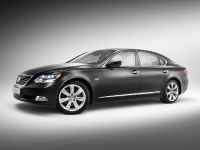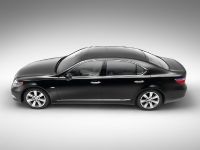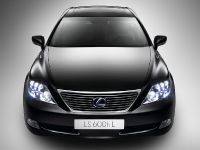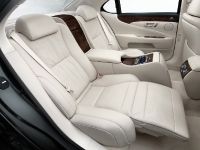Lexus LS 600h
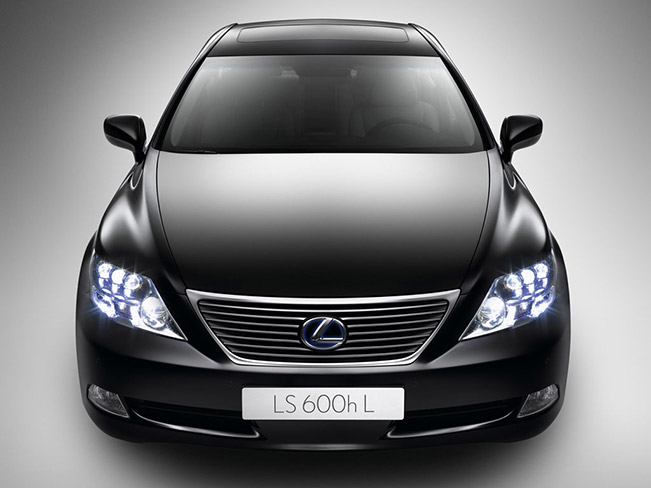 The new LS 600h adds Lexus' revolutionary hybrid technology to the unique values of L-finesse design, the world's most advanced safety technology and the highest possible standards in production, quality and comfort expressed in the LS 460, to create a vehicle which explores the outer reaches of luxury car performance, design, safety and efficiency, whilst offering the ultimate in sophisticated and engaging driving experiences.
The new LS 600h adds Lexus' revolutionary hybrid technology to the unique values of L-finesse design, the world's most advanced safety technology and the highest possible standards in production, quality and comfort expressed in the LS 460, to create a vehicle which explores the outer reaches of luxury car performance, design, safety and efficiency, whilst offering the ultimate in sophisticated and engaging driving experiences.
From the outset, the Lexus philosophy has been to develop cars that establish new frontiers in quality, luxury and performance through a radical approach to advanced vehicle design, whilst stressing absolute customer orientation at the very core of the marque.
In taking a leading global role in the development of performance hybrid vehicles, Lexus has revolutionised the premium automotive segment by awarding its customers a unique, sophisticated, intelligent driving experience which utilises the ultimate in high technology power trains to marry environmental responsibility with peerless quality and involving driving dynamics.
Toyota Motor Corporation's (TMC) credentials in developing environmentally-friendly hybrid vehicles date back over 40 years to 19 65, when it began the investigation of the use of gas turbines to power an electric drive system for cars. TMC's inception of the Toyota Eco Project in January 1997 was followed, in March, by the completion of the Toyota Hybrid System (THS), a brand new powertrain in which a petrol engine and an electric motor operate in tandem, each within their optimum efficiency range.
THS was installed in Prius, the world's first volume production hybrid passenger car, which went on sale in the Japanese market in November 1997 and has since sold over 639 ,000 units around the world. In 2005, the RX 400h SUV's Lexus Hybrid Drive, a second generation development of THS, introduced class-leading performance to the equation through a 150% increase in electric motor power. And in 2006, the GS 450h became the world's first hybrid luxury saloon, and the first full hybrid to combine front engine mounting with rear-wheel drive.
Following the RX 400h and the GS 450h, the new LS 600h luxury flagship is the marque's third vehicle to feature the revolutionary hybrid system. Lexus remains the first, and only, premium automotive segment manufacturer offering a comprehensive hybrid model range available today.
The LS 600h introduces Lexus' revolutionary, high-performance hybrid drive technology to the flagship of the luxury marque for the first time.
The LS 600h is the world's first vehicle to feature a full hybrid V8 powertrain, combining a technologically peerless 5.0 litre petrol engine with a powerful, high-output electric motor, a newly designed, largecapacity battery pack, electronically controlled continuously variable transmission and permanent all-wheel drive. As with the Lexus RX and GS hybrid models, the LS 600h's ‘600' suffix refers not to the cubic capacity of the engine but, rather, a power output comparable to that of a conventional, 6.0L V12 petrol engine.
This state-of-the-art powertrain technology will equip the LS 600h with an unequalled balance of performance and environmental efficiency. A peak combined output rating of over 327kW/445DIN hp (*) offers the power and performance of a normally aspirated V12 engine. Conversely, the hybrid Lexus flagship offers a class-leading combined fuel consumption figure of less than 9.5l/100km(*) and CO2 emissions below 220g/km(*).
Owing to the inherent Noise, Vibration and Harshness (NVH) improvements offered by its hybrid powertrain, the LS 600h is designed to set a new standard for silent running in the premium automotive segment, with an unparalleled depth and density of cabin quietness, resulting in quite possibly the quietest luxury car in the world.
The long-wheelbase LS 600h L offers the ultimate ownership experience with an additional 120mm dedicated entirely to rear passenger legroom. It can be equipped with a range of comfort features unique to this class, including reclining seats with leg rest, a Rear Seat Relaxation System and a second DVD changer for individualised rear seat entertainment. In addition, the LS 600h L features innovative technology such as a rear seat cushion airbag and a sophisticated, infrared, body heat sensing climate control system to offer rear seat passengers the ultimate, 1st class luxury travelling experience.
DE SIGN
The new LS 600h is the ultimate expression of L-finesse, the unique Lexus design philosophy, demonstrating that a premium automotive segment saloon can be understated, yet inspiring. L-finesse has its roots in the creation of a harmonious balance of contrasting elements. The new LS 600h encompasses this design direction with styling which is both vivid and forceful yet, at the same time, warm, inviting and entirely contemporary. With its long cabin, broad, purposeful groundhugging stance, and elegantly sculpted, streamlined body contours, the hybrid Lexus luxury flagship emphasises simplicity and style in a stunning, modern package.
The LS 600h may be differentiated from the rest of the LS model range through discreet ‘hybrid' badging, bespoke, hand-polished alloy wheels, Black Opal –a hybrid-exclusive jet-black body colour revealing blue and purple undertones in bright sunlight, and the world's first LED low-beam headlamps. The circumference of each of three LED projector lenses is fitted with a transparent blue ring, giving the Lexus hybrid flagship a unique, readily identifiable headlamp signature. In addition, discreet blue detailing of the rear lights and the front logo sets the LS 600h apart.
On board, the LS 600h may be further identified as the flagship of the LS model range through a painstakingly crafted, full-leather instrument panel, and the peerless finish of real wood highlights, including the gear shift lever and over-door assist grips.
POWERTR AIN
The Lexus Hybrid Drive employed in the high performance flagship of the LS model range combines an all new, longitudinally-mounted 5.0L V8 petrol engine with a high-output electric motor and a newly designed, large-capacity battery pack. This state-of-the-art hybrid drive system equips the LS 600h with an unparalleled balance of performance and environmental efficiency. Generating a peak combined power output of 327kW/445DIN hp (*), whilst delivering a class-leading combined fuel consumption figure of less than 9.5l/100km (*) and CO2 emissions below 220g/km (*).
Hybrid System Components
Derived from the LS 460's 4.6L powerplant with the stroke extended by 6.5mm and the bore unchanged, the new 5.0L V8 engine is a showcase of precision mechanical engineering, the most technologically advancedinternal combustion engine ever to have been developed by Lexus engineers. The painstaking development of high rigidity components, optimum balance in all moving parts, minimisation of friction and unprecedented precision of assembly awards the new V8 benchmark performance in the fields of refinement and quietness.
To reduce the overall weight of the engine, the cylinder block is die-cast from a lightweight, high strength aluminium alloy. The block structure and rib reinforcement design have been finalised through the incorporation of cylinder combustion pressure data to minimise both vibration and noise, and the cylinder head cover is constructed in a lightweight magnesium alloy to lower the powerplant's centre of gravity.
In addition to an increase in cubic capacity over the 4.6L 1UR-FSE powerplant, the new 2UR-FSE 5.0L V8 has undergone significant component modification in order to handle its unprecedented power output, including revisions to the pistons, crankshaft, connecting rod, damper pulley, VVT-iE (Variable Valve Timing intelligent by Electric motor), exhaust manifold and all-wheel drive-compatible oil pan.
Due to the fuel economy penalties inherent in both the increase in engine capacity and the LS 600h's all-wheel drive system, Lexus engineers have also fine-tuned numerous aspects of the powerplant's operation, including adjusting the operating angle of Dual VVT-i, to achieve a 3.0L-class fuel economy.
Furthermore, particular attention has been paid to the absolute minimisation of Noise, Vibration and Harshness, as befitting the uniquely quiet operation of the Lexus hybrid system. To minimise engine stop/start vibration, the intake valve timing has been delayed to lower the compression ratio during restarts. Insulation materials have been applied to the cylinder head covers, and the size and location of engine mounts have been optimised.
The new V8 features a D-4S stoichiometric direct injection system, the world's only high compression ratio injection system to adopt two injectors per cylinder. It combines the strengths of both direct and port injection, realising optimum engine efficiency throughout the power band and improving torque by 7.5% across the rev range, whilst minimising fuel consumption and emissions. D-4S also substantially reduces combustion fluctuations in comparison to any conventional, direct or port injection system.
The 5.0L powerplant is also equipped with Dual VVT-i. This optimised, low pressure loss, variable intake and exhaust timing system incorporates VVT-iE, the world's first electric motor driven intake camshaft, which operates across the full engine revolution and temperature spectrum. The LS 600h's Lexus Hybrid Drive employs a highly compact, three-phase, permanent magnet AC synchronous type motor, operating on a 650 Volt current to deliver more than 165kW/224DIN hp. Extensive remodelling of magnet distribution has achieved extraordinarily quiet operation, whilst coiling the magnetic alternate for optimum magnetic force retention has resulted in a smoother, more stable motor rotation.
In addition to both petrol engine and electric motor power sources, the hybrid system further comprises a generator, a high-performance battery, a power split device which combines and re-allocates power from the engine, electric motor and generator according to operational requirements, and a Power Control Unit (PCU) to govern the high speed interaction of the system components.
To optimise delivery of the Lexus hybrid system's immense power, a new, mechanical, all-wheel drive system offers superior traction and handling stability, whilst a newly developed, two-stage motor-speed reduction device and electronically controlled continuously variable transmission offers smooth, linear power delivery and superlative overtaking performance.
As in the GS 450h, the Lexus' hybrid system electric motor, generator, power split device and two-stage motor-speed reduction device are all housed in one lightweight, highly compact transmission casing. The combined installation of these components within a single casing directly comparable in size to that of a conventional gearbox is fundamental to the successful installation of Lexus' sophisticated hybrid drive system in a longitudinal, front-engined sedan platform.
Equipped with an Electronically Controlled Continuously Variable Transmission, the LS 600h provides breath-taking, linear acceleration. As the hybrid ECU selectively controls both engine and electric motor rpm, the Electronically Controlled Continuously Variable Transmission simulates a continuous variation of the transmission's current ratio. Similar to that of the GS 450h, the two-stage motor speed reduction device is automatically and seamlessly switched between low and high motor reduction ratio settings by a hydraulic control unit, generating maximum low-gear torque for significantly enhanced acceleration, as well as extended high-gear performance for quiet, high speed cruising with improved fuel efficiency. Via a centre console mounted Mode Select switch, the new transmission offers a choice of three power settings; ‘Normal', for the optimum balance of power and traction, ‘Power', for maximum acceleration, and ‘Snow', for excellent traction control under the most slippery road conditions.
The hybrid system in operation
Over the course of any journey, Lexus' Hybrid System operates in several different modes to maximise the LS 600h's overall efficiency: Under operating conditions of low engine efficiency such as start up and low to mid-range speeds, the vehicle runs on the electric motors alone, thus eradicating both engine noise and CO2 emissions. Furthermore, the system imbues the vehicle with similar in-gear ‘creep' to that of a conventional automatic transmission.
Under normal driving conditions, the ultra-efficient V8 powerplant serves as the main power source. Engine output is divided by a power split device to both drive the wheels directly and power the generator which, in turn, drives the electric motors and simultaneously charges the high-voltage battery. In these circumstances, power allocation is constantly monitored and adjusted between engine and motors to maximise efficiency. When sudden acceleration is required, engine and electric motors again operate in tandem, with extra power supplied from the battery to boost motor response, providing a superlative, seamless, linear power delivery.
During deceleration and under braking, the combustion engine switches off and the high-output electric motor acts as a generator to effect regenerative braking, optimising energy management in the Lexus Hybrid Drive by recovering kinetic energy (wasted as heat under braking and deceleration) as electrical energy for storage in the high performance battery.
When the engine is cold and the ignition is switched on, the system will start the engine to warm the unit, running at an engine speed that provides the highest possible efficiency. Thereafter, at rest, the engine stops automatically to conserve fuel. However, if the vehicle is at idle for prolonged periods, the engine will automatically run whenever necessary to charge the high-voltage battery via the generator. Furthermore, under all driving conditions, battery power level is constantly managed via a hybrid ECU that prevents it from reaching extreme levels, hence maximising battery life expectancy.
The Lexus hybrid powertrain delivers extremely smooth, linear acceleration, with none of the expected ‘jumps' between gears of a conventional drivetrain. Under every driving condition, at whatever speed, Lexus Hybrid Drive offers a significantly higher level of drive-train refinement than that of a conventional powerplant.
AMICS
The Lexus LS 600h features the world's first, full-time, all-wheel drive hybrid powertrain. The LS flagship further benefits from electrical air suspension system, optional Active Stabiliser control and the second generation of Lexus' state-of-the-art Vehicle Dynamics Integrated Management (VDIM) system incorporating Variable Gear Ratio Steering (VGRS) cooperation.
All-wheel drive
The LS 600h's all-wheel drive features a three differential configuration and a propeller shaft, coupled directly to the hybrid transmission. A permanently engaged mechanical transfer system distributes drive power with a ratio of 40% to the front wheels and 60% to the rear. A TORSEN® Limited Slip Differential (LSD) was adopted for its highly responsive torque distribution qualities, enhancing grip, traction, stability and vehicle handling under all road conditions, whilst delivering the rear wheel drive characteristics essential to a dynamic, premium segment sedan. In order to accommodate the gear transfer without sacrificing interior legroom, Lexus engineers rejected even the smallest and lightest TORSEN® LSD system currently available, developing a new unit some 30% smaller and lighter than any in existence, with both transfer and differential housed in a single casing.
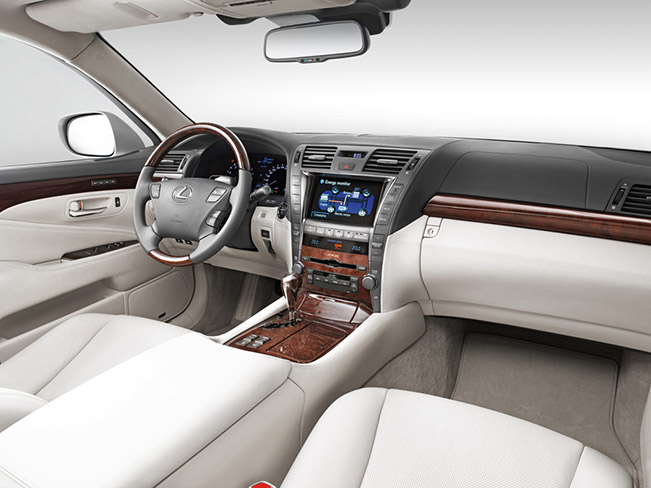
Air Suspension with Active Stabilisers and Adaptive Variable Suspension (AVS)
Featuring a significantly revised front suspension configuration to harness the power of the LS 600h's all-wheel drive transmission, The Lexus flagship's all-round multilink suspension system utilises new pneumatic cylinder operating in co-operation with an improved Adaptive Variable Suspension system (AVS), which features a vehicle posture control system to synchronise vehicle roll and pitch when cornering, for maximum passenger comfort. The Lexus hybrid flagship further benefits from Active Stabilisers to reduce body roll when cornering and, hence, achieve the LS 600h's excellent dynamic abilities.
The Active Stabiliser system features an actuator centrally located on both front and rear stabiliser bar. The actuator comprises a DC brushless motor with attendant reduction gear, capable of applying torque to both left and right hand sections of the stabiliser bar. A system ECU calculates the twist torque output required based on sensor fed steering angle and vehicle velocity information. The twist force applied to both front and rear stabiliser bars by the highly responsive system controls vehicle roll motion, reducing body roll angle to promote ensured vehicle stability, superior cornering performance and improved agility through enhanced steering response.
Adaptive Variable Suspension (AVS) allows the driver to fine tune the LS 600 h's ride characteristics with a choice of three damper settings activated via a switch adjacent to the gear lever; ‘Normal' mode, for everyday driving, ‘Comfort', for improved comfort on more degraded road surfaces, and ‘Sport' mode, for improved body control and precise responses to steering input whilst cornering. In any mode, AVS automatically adjusts the erformance of the suspension at all four wheels independently, monitoring data from numerous sensor locations to continuously optimise the damping force of each shock absorber through 9 incremental steps via actuators. Simultaneously, VGRS automatically reduces the steering gear ratio by approximately 10% whilst the Electric Power Steering (EPS) simultaneously increases steering assist torque by some 4%. These measures combine to minimise body roll, sharpen vehicle handling and optimise steering feel for the ultimate in sports sedan driving.
A new damping force control logic is incorporated within the Adaptive Variable Suspension system to minimise the phase difference between body roll and pitch angles during cornering. Research by Lexus engineers has revealed that a large phase difference between roll and pitch angles can cause driver discomfort by exacerbating the perception of vehicle body roll whilst cornering.
This phase synchronisation elicits a smooth, controlled roll whilst cornering, with a well-matched vehicle response to steering, yaw and roll, and an enhanced perception of rear tyre grip.
Vehicle Dynamics Integrated Management (VDIM)
The new LS 600h is equipped with the latest generation of Lexus' state-of-the-art Vehicle Dynamics Integrated Management (VDIM) system, specifically developed in conjunction with the Lexus hybrid flagship's all-wheel drive transmission to enhance traction control and vehicle stability. With comprehensive status data provided by sensors throughout the vehicle, VDIM integrates the LS 600h's Electronically Controlled Braking (ECB), Anti-Lock Brakes (ABS), Electronic Brakeforce Distribution (EBD), Traction Control (TRC) and Vehicle Stability Control (VSC) active safety systems with the Adaptive Variable Suspension (AVS), Electric Power Steering (EPS) and Variable Gear Ratio Steering (VGRS) systems.
Unique to the Lexus flagship, the LS 600h drive-train's Driving Response and Acceleration Management System (DRAMS) alsoaffords VDIM unprecedented interaction with both engine and transmission, employing engine and electric motor output control to effect a faster, smoother and more precise response to situations involving the possibility of a loss of traction, such as mid-corner gear changes.
Whereas conventional active safety systems are only activated immediately after a limit of the vehicle's performance envelope has been reached, VDIM progressively engages before that limit is realised. As a result the system offers smoother vehicle behaviour at this threshold through less obtrusive intervention and, hence, a more pleasurable drive.
PRE VENT IVE SAFETY AND DR IVER ASSISTANCE SYSTEM S
Appropriate to the high-performance flagship of the Lexus brand, the new LS 600h is a showcase of numerous revolutionary developments in the field of preventive safety technology, based on the principle of accident avoidance through intelligent anticipation. Unique to the luxury hybrid saloon, the LS 600h is also equipped with the world's first application of low-beam LED headlamp technology.
Advanced Pre-Crash Safety system (PCS)
A significant development of the system already featured in the IS and GS model range, the LS 600h's Advanced Pre-Crash Safety system (Advanced PCS) offers maximum assistance to the driver in collision avoidance, either by day or night. The Advanced PCS now incorporates four world firsts; an Advanced Obstacle Detection System, a Driver Monitoring System, Emergency Steering Assist and a Rear Pre-Crash Safety system. These sophisticated innovations alert the driver to potentially hazardous situations, promote optimum vehicle responsiveness during evasion manoeuvres and reduce the consequences of a collision.
Advanced Obstacle Detection System
The Advanced Obstacle Detection System combines information sourced from both a millimetre wave radar and an infrared stereo camera. The millimetre wave radar is mounted within the LS 600h grille, scanning the road ahead. The stereo camera consists of two near-infrared CCD lenses mounted 350mm apart at the head of the windscreen, which transmit digital video images. Near-infrared projectors built into the highbeam function of the headlamps help obstacle detection at night, beyond the range of the low-beam headlamps. Subject to weather conditions, the Advanced Obstacle Detection System can identify a wide range of obstacles, including, for the first time, pedestrians.
Driver Monitoring System (DMS)
The Advanced Pre-Crash Safety system also features the world's first Driver Monitoring System. This system employs a CCD camera, mounted on top of the steering column cover, which is equipped with six built-in near infrared LEDs to give an identical detection performance by day or night.
First using an algorithm to detect the position of the facial features (eyes, nose and mouth) and measure the width and centre line of the face, the Driver Monitoring System is able to monitor the movement of the driver's head when looking from side to side. If the driver turns his or her head away from the road ahead at an angle of more than 15 degrees whilst the vehicle is in motion and an obstacle is detected in front of the LS 600h, the system will automatically activate the Pre-Crash warning buzzer function and even briefly apply the brakes to alert him to the situation. If the driver does not respond immediately, The PCS system will automatically engage the subsequent operational sequence of the Pre-Crash functions.
Emergency Steering Assist
Through a close interaction between the Variable Gear Ratio Steering (VGRS), Vehicle Dynamics Integrated Management (VDIM) and Adaptive Variable Suspension (AVS) systems, Emergency Steering Assist substantially improves the LS 600h's response to the driver's steering input in the likelihood of a collision, increasing the chance of avoiding the obstacle.
To effect a rapid evasion manoeuvre, the VGRS actuator reduces the steering gear ratio to provide more direct steering and a faster response to driver inputs. Simultaneously, the AVS suspension adopts a stiffer damper setting to minimise body roll, optimising chassis balance for an improved vehicle response to sharp steering inputs. In addition, VDIM offers selective brake control through the integration of the LS 600's active safety systems to maintain vehicle stability throughout the evasion manoeuvre.
Rear Pre-Crash Safety system (RPCS)
Operating whether the LS 600h is stationary or in motion, the Rear Pre-Crash Safety system employs a millimetre-wave radar installed within the rear bumper to constantly scan the area around the back of the vehicle. If a collision is deemed unavoidable, the system automatically activates the front seat Pre-Crash Intelligent headrests, which move up to 60mm forwards and 25mm upwards to cushion the occupant's head in anticipation of an impact, greatly reducing the risk of whiplash injury.
Adaptive Cruise Control with Full-Speed Following Function
Complementary to the Advanced PCS system, the LS 600h also features a new Adaptive Cruise Control with Full-Speed Following Function. As with standard ACC, the system offers two modes -constant speed control, and vehicle-to-vehicle distance control- but is now capable of operating at any vehicle speed between 0 and approximately 17 0 km/h.
The vehicle-to-vehicle distance control system employs both the millimetrewave radar sensor and stereo imaging camera of the Advanced Obstacle Detection System. Thanks to the system's full-speed range following function, aclose proximity distance measuring ability, the new Low Speed mode enables ACC to operate in slow or congested traffic for the first time, and, with limited braking and acceleration performance, the system can both bring the Lexus flagship to a complete standstill, and accelerate away once the road ahead is clear.
LED Low-Beam Headlamps
The LS 600h is equipped with the world's first application of low-beam LED headlight technology, offering excellent illumination and significantly improved durability over conventional lighting systems. Based on multiple LED lamp design principles explored in the LF-X concept car, the new system employs a 5-lamp low-beam configuration. Three upward oriented LED lamps focus high intensity illumination directly ahead via an overlapping horizontal array of three projector lenses.
The remaining two, downward oriented LED lamps employ a shielded parabolic cylinder to create wide angle light projection the three projector lenses are fitted with a transparent blue ring, giving the Lexus hybridflagship a unique, readily identifiable headlamp signature.
The LS 600h's low-beam LED lamps boast instantaneous lighting, in approximately 0.1 seconds, emit a white-light colour closest to that of natural daylight and have an lifespan longer than conventional lighting systems, with minimal degradation in light intensity. The combination of a three lamp projector array and twin lamp parabolic reflector optimises illumination across the full width of the road ahead, significantly improving visibility of the opposite side of the road with no increase in glare to oncoming traffic.

